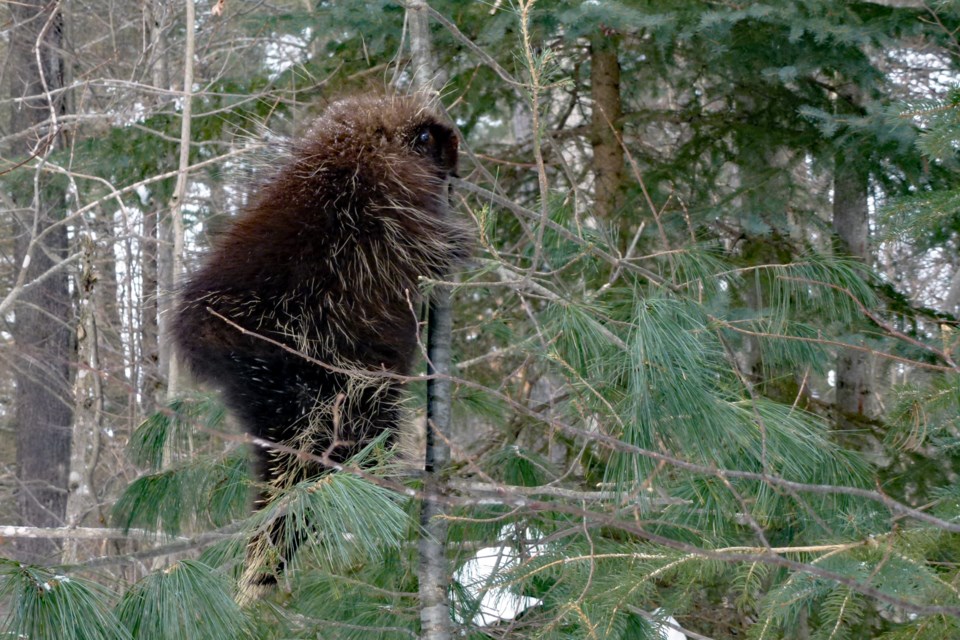As I wander down the many trails that our region has the good fortune to host, there are a myriad of things to observe, from flowers to birds to lichens to just the scenery itself. Pretty cool!
However, over the last few years, I am finding that something is missing ... porcupines.
Having grown up in this area, spending every holiday and weekend at a farm of my grandparents' or uncles,' porcupines were a ‘given’ to find on a woodland walk. Perhaps sitting obviously in a branch of a sugar maple, or tucked quietly against the trunk of a balsam fir, these mammals were considered quite common to us.
Nowadays, porcupines, like groundhogs, are much reduced in their occurrences. Oh, a few are still scattered around, but due to changes in farm crops, reduced sizes of woodlots, and faster travel on ‘backroads’, these animals are taking the brunt of the ongoing human invasion.
In his book The World of the Porcupine, David Costello provides a wonderfully descriptive introduction to the porcupine: “… that nothing is more peculiar than a porcupine. He waddles when he walks. He minds his own business. He runs from nothing. And he never starves. He is pigeon-toed and bow-legged. He has feet like a bear, teeth like a beaver, claws like a badger, and inner fur like the wool on a sheep. He can swim, croon a love song, climb the tallest tree, and eat with his hands.”
Yep, that about covers it!
Porcupines are rodents, second largest to the beaver. As rodents, they like to chew things: tree bark, shed deer antlers, cottage steps, plywood signs, paddles left under a canoe, and anything leather they can find. Indeed, finding the remains of a porky’s chewing’s are usually the most common way of knowing that they are in the area.
Unfortunately, these objects of culinary desire are also objects of human use. As cottage country opened up to weekend users and not just multi-week voyageurs, a war was raged against the prickly gnawers. And to add insult to injury, Fido would ruin a perfectly good cottage weekend vacation get-away by getting snout full of quills. Bad porcupine!
And maple syrup producers didn’t take kindly to having trees girdled by sap hungry porcupines. I have to confess that back in the 1960s I shot a fair number of them to appease my sap-boiling relatives. It’s what you did. That, and shoot the groundhogs that popped up in the clover fields.
And here we are now, 60 some years later, and nary a porcupine nor groundhog to be seen. Perhaps in some small way this is the result of my ‘sharp shooting days’, but more so the result of the very different landscape of today: woodlots are now fragmented into small pieces that restrict the travels of wildlife; crops of soy and corn cover many sprawling acres of what used to be a mix of hay, alfalfa and clover; and one-by-one the ‘nuisance’ porky’s have been dealt with along popular dog-walking trails.
There is a natural predator of porcupines which is increasing its population in our neighbourhood, and that is the fisher. The fisher matches the porky in tree climbing ability, but is way, way faster. As the porky lumbers upwards, the fisher darts around the tree and keeps nipping at the un-quilled throat of the porcupine.
When the prey becomes weakened from blood loss, it falls to the ground where the fisher can finish its meal. Interestingly, fisher fur and skin do allow the quills to take hold readily. When I observed several dozen fisher pelts at a fur auction (years ago) many had old porcupine quills still embedded in the fur, requiring the fur graders to wear steel mesh gloves while handling the raw pelts.
A while back I found evidence of a porcupine in a most unusual circumstance: as I came down the trail, I noticed a fresh branch from an aspen tree laying across the trail. Not too big a branch, only about two inches in diameter, yet big enough to block half the trail's width. As I bent down to throw it aside I noticed several porcupine quills laying on the ground.
"Oh, bother," I thought. "Someone has used this to beat up a porcupine!" However, closer examination showed that most of the quills were actually embedded in the ground. With the branch removed, the quill pattern in the soil took on a definite outline of a young porcupine.
Then I looked up, way up, to a point about 40 feet above my head where a slight, fresh scar appeared on the aspen tree. It appears the porky had clambered out on the branch in search of leaves to eat, and the half rotted branch had given way. Down fell porky, branch, leaves and all!
I looked at the trail of other broken quills where this no-doubt seriously winded and bruised porcupine had toddled off. Will it survive? And if so, will it ever willingly climb another tree?
The baby porcupines are born in early spring (as are baby skunks, white-tailed deer, and cottontail rabbits). There is but one “porcupette” (as they are called scientifically) born to a mother each year, so population growth is slow. When born the quills are soft and pliable, but within a day or so they harden and make a great defence against off-leash dogs and inquisitive coyotes.
But a few remain, you just have to have patience and keen eyes to find them. “Eyes open” while out walking ... check those balsam fir and young hemlocks along the trail sides, and maybe, just maybe, you’ll find one of the woodland’s most peculiar animals.



